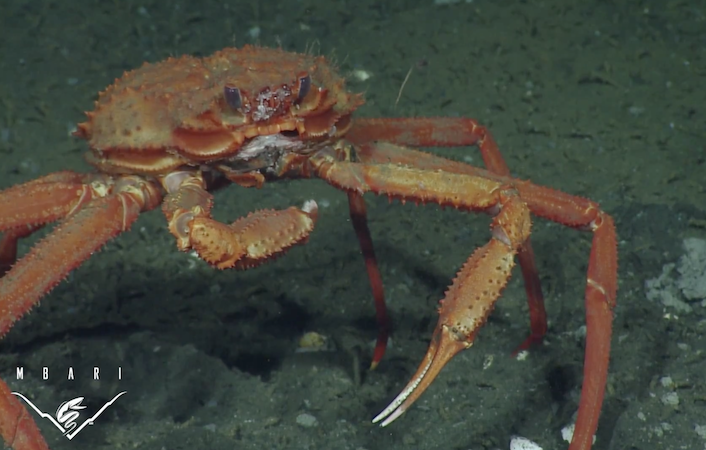Methane Meal: Deep-Sea Crab Gets an Icy Surprise

In the ocean's inky depths, crabs scavenge for meals by tracking vibrations from sound and movement. For one crab, that meant a stream of icy methane bubbles seemed like a potential meal — until the methane froze onto its claws and mouth.
Scientists from the Monterey Bay Aquarium Research Institute (MBARI) watched the scene unfold in August 2011 on video shot by a remotely operated vehicle. The researchers were offshore of Vancouver Island, British Columbia, Canada, where naturally occurring methane seeps from the seafloor through cracks and faults, said Peter Walz, an MBARI research technician who was on the expedition.
"It was pretty obvious that the crab was intent on going to the gas vent, but we had no idea what he was going to do or why. The crab was doing his own investigation of what we were investigating," Walz told LiveScience. [Watch the curious crab]
The deep-sea crab's methane mustache was a result of the chilly temperature and high pressure at the methane seep, about 4,130 feet (1,260 meters) below sea level. When methane gas escapes from submarine sediments at this depth, the bubbles have a frozen skin called methane hydrate, with gas trapped inside, Walz explained. This skin was the first layer of methane ice on the crab's claws. But any agitation in the gas stream, such as when the crab waved its claws in the bubbles, transforms the methane gas into methane hydrate, Walz said.
"The hydrate forms more readily with increased agitation or shaking, such as the movements of the crab," Walz told LiveScience.
After the crab scraped off the methane hydrate and wandered away, the researchers continued their survey of the methane seep, called the Bullseye Vent. Their research helped confirm that large pockets of methane gas can change the shape of the seafloor.
Editor's note: This story was updated Aug. 12 to correct the depth of the methane seep in meters.
Sign up for the Live Science daily newsletter now
Get the world’s most fascinating discoveries delivered straight to your inbox.
Email Becky Oskin or follow her @beckyoskin. Follow us @livescience, Facebook & Google+. Original article on LiveScience.com.











